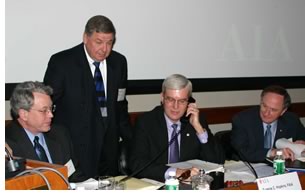

FROM
THE PRESIDENT’S OFFICE
It’s the People

 by
Eugene C. Hopkins, FAIA
by
Eugene C. Hopkins, FAIA
AIA President
I want to take this opportunity in this my final column as your President to shine the spotlight right where it belongs—on people. I want to share a few thoughts about the progress we’ve made together in guiding a more people-oriented, grassroots AIA that reaches out and embraces others.
Despite what we often read, architecture is not primarily about form. It’s not really about styles or even technologies. Architecture is about people. It’s about the clients who commission the work, the team that designs and builds a project, the users, and the community. It’s something of a cliché, but no less true because of that: Without people, where would we architects be?
Topping the agenda…
This commitment to serving and connecting with people shows up in the
national component’s agenda in many ways. For example, we can
all take great pride in the AIA’s continuing fiscal discipline.
That discipline provides the resources AIA members need to be successful.
It’s what allows the AIA to be a forward-looking organization
that prepares its members for innovation and invention on behalf of
the people we serve.
I’m proud of the progress we’ve made in becoming a knowledge-based organization. The growth of the AIA’s knowledge communities has been nothing short of incredible. Not only are the knowledge communities growing in size, they’re becoming more diverse, more engaging of our profession, and more committed to sharing.
As was reported several months ago, the AIA entered with others into a precedent-setting partnership with the Enterprise Foundation. We launched the Green Communities Initiative, a five-year, $550-million commitment to build before this decade is over more than 8,500 environmentally friendly, affordable homes nationwide.
This commitment to touch those most in need is driving current initiatives to reinvigorate our RUDATs and SDATs through the AIA’s new Center for Communities by Design. This is a commitment AIArchitect readers will want to keep an eye on. Expect great things.
Bringing order to the industry
One of the first tasks the AIA set for itself when it was founded nearly
150 years ago was to bring order to the design and construction industry.
This commitment led to the creation of the AIA’s standard contract
documents, which became the bedrock of the industry. Today, the newly
enhanced electronic format AIA Contract Documents serve a complex and
fast-moving marketplace by providing greater flexibility, ease of use,
and immediate availability.
The AIA’s success in serving the contractual needs of our profession and our clients touches our members in another way. By the end of this year, we anticipate $2.9 million in revenue will be shared with all AIA components.
Touching people at many levels
AIA members feel the value of their professional society most profoundly
at the local level. It’s clear we had to find the resources to
enable the success of those who work tirelessly at the grassroots.
And today we’re doing just that.
The AIA is also a gathering place for members who practice abroad. Our international chapters bring together extraordinary talents and experiences. Knowledge is shared, and the bonds of fellowship that unite our profession as a community are strengthened. At the same time, our advocacy of continuing education and the transportability of the architectural license is enhanced.
The fact that the AIA touches many people is not news. What’s different and what gives me great pride is that today we are choosing our priorities and committing our resources guided by a clearly written, transparent plan that intelligently directs our work toward four strategies: advocacy, community, knowledge, and value. It’s a plan that in its simplicity and clarity serves as a template for collaborative planning among all the AIA components. It’s a plan that facilitates sharing, empathy, relationship building, and connectivity.
Great experiences
On a more personal note, this past year has been the experience of a
lifetime. It’s been an experience I will cherish because of all
the people I have had the privilege of working with, coming in contact
with, networking with, socializing with, or just sharing a chance meeting
because the opportunity presented itself.
These experiences have fed within me a new optimism—optimism for this organization just three years shy of celebrating its 150th anniversary, optimism for the future achievement of this profession as it applies a growing body of knowledge in new ways to serve our clients, and optimism for the growing appreciation of the power of architecture to elevate and enrich the human spirit.
Last June, AIA members gathered in Chicago for what turned out to be the largest community of architects in our history! Above everything we did there seemed to hover the spirit of the great Daniel Burnham. It was Burnham’s optimistic vision back in 1893 that showed the world not what cities were, but what they could be. Like Burnham, we had a vision for Chicago: we learned, we celebrated, and we dreamed about the power of design to make this a better world.
Daniel Burnham is one of the great achievements of our profession. He certainly has been a guide to me, and I find it fitting as we set our course for an even greater future to turn to him for advice: “Make no little plans; they have no magic to stir men’s blood.”
His challenge to us is mine to you: Make no little plans. Reach for magic and touch our hearts.
It’s been an honor and privilege to serve!
Copyright 2004 The American Institute of Architects.
All rights reserved. Home Page ![]()
![]()
 |
||
| Pictured, in one of his last—and most pleasant--official duties as AIA President, Gene Hopkins telephones 2005 AIA Gold Medalist Santiago Calatrava, FAIA, as (left to right) 2005 AIA President Douglas L Steidl, FAIA; Calatrava’s sponsor Edward Kodet, FAIA; and AIA EVP/CEO Norman L. Koonce, FAIA, listen in. Photo © Douglas E. Gordon, Hon. AIA.
|
||